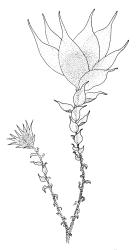Plants small or minute, with pale, fleshy subterranean primary stems and short, erect shoots. Leaves on shoots small below, gradually larger and more crowded above, broadly ovate, elliptic, or obovate, obtuse, acute, or piliferous at apex, concave; margins plane and ± entire; laminal cells oblong, oblong-rhombic, or oblong-hexagonal throughout, mostly thin-walled, smooth, often ± thickened at corners, not differentiated at margins. Costa single or none.
Sexuality variable. Perichaetia terminal, with paraphyses (if present) filiform. Setae very short (in N.Z. species) to moderate in length; capsules immersed or exserted, operculate or inoperculate, gymnostomous, globose or hemispheric, usually spongy and wrinkled when dry; stomata restricted to capsule base, with 2 guard cells or imperfectly divided, resulting in a single cell with a central slit. Operculum plano-convex or absent. Spores moderately to very large. Calyptra small, mitrate or cucullate, fugacious.
The family consists of five monotypic or ditypic genera occurring predominantly in the southern hemisphere, but with some extensions northward to the Mediterranean, Mexico and Texas. Only Gigaspermum occurs in N.Z.
The family is traditionally placed near the Funariaceae, owing to occurrence in weedy habitats on mineral soil, often lax areolation of leaves, which are usually few and crowded in comal clusters, and stomata sometimes a mere slit in imperfectly formed guard cells. The subterranean and rhizome-like stem, laminal cell walls often wavy and thickened at corners, commonly reduced costae, filiform paraphyses, and spongy capsules give meaning to the family. Goffinet et al. (2009) placed the family in the subclass Funariidae, but in its own order, the Gigaspermales. Additional information on the family is provided by Fife (1980) and Magill (1987). Goffinet et al. removed the poorly-known Latin American genus Neosharpiella from this family and placed it in the Bartramiaceae.
| Category | Number |
|---|---|
| Indigenous (Non-endemic) | 1 |
| Total | 1 |




